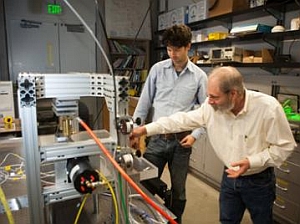Engineers and earth scientists at University of California in Berkeley built a physical earthquake fault model in the lab that can assess the vulnerabilities of buildings and other structures when an earthquake happens. The study reporting on the model, first-authored by Gregory McLaskey now at the U.S. Geological Survey in Menlo Park, California, appears in this week’s issue of the journal Nature (paid subscription required).
The model simulates the behavior of earthquake fault lines, particularly the time needed for fault to heal from a previous earthquake. From the model, researchers can simulate and measure shock waves at a frequency higher than 100 hertz that usually occur well beneath the surface of the earth, and thus are absorbed before they can be measured in real time.
Yet these higher frequency waves are critical to understanding the potential impact of earthquakes on modern infrastructure. McLaskey notes that “those high frequency waves are what matter most when it comes to bringing down buildings, roads and bridges, so it’s important for us to understand them.”
The fault simulator built by McLaskey and colleagues has a plexiglas slider block against a larger base plate, with an array of sensors. The system design allows the researchers to isolate friction and other physical or mechanical factors that affect the way the ground shakes when a fault ruptures. That kind of detailed fault behavior study would be impossible on acutal faults well below the earth’s surface.
Other research on earthquakes, says McLaskey, study properties of friction in the lab or motion of earthquakes in the field. “What this study does for the first time is link those two phenomena,” McLaskey adds. “It’s the first clear comparison between real earthquakes and lab quakes.”
The model indicates that as fault surfaces heal, or move back together, individual contact points along the surfaces slip and transfer the resulting energy to other contact points. Steven Glaser, an engineering professor at Berkeley and principal investigator on the project, says “the stress is transferred to other contact points in a chain reaction until even the strongest contacts fail, releasing the stored energy as an earthquake.” Glaser notes as well that “The longer the fault healed before rupture, the more rapidly the surface vibrated.”
The Berkeley engineers, joined by earth scientists at the Berkeley Seismological Laboratory, tested their lab measurements against records of real earthquakes at Parkfield, California, which has experienced magnitude 6.0 earthquakes two to three decades apart over the past 150 years. Of particular interest were the small repeating earthquakes that recurred more frequently on the same fault patches in the years following a magnitude 6.0 earthquake at Parkfield in 2004.
Amanda Thomas, an earth science graduate student and co-author of the publication says of the Parkfield data, “Measurements of the ground motion generated from each of the small earthquakes confirmed that the shaking is faster when the time from the last rupture increases.” The Parkfield data, when compared to the model, she adds, “provided an excellent opportunity to verify that ground motions observed on natural faults are similar to those observed in the laboratory, suggesting that a common underlying mechanism — fault healing — may be responsible for both.”
Glaser points out that these findings can have benefits for architects and planners in earthquake-prone regions. “The experiment in our lab allows us to consider how long a fault has healed and more accurately predict the type of shaking that would occur when it ruptures,” says Glaser. “That’s important in improving building designs and developing plans to mitigate for possible damage.”
Read more:
- Grant to Fund Research on Earthquakes, Building Design
- Engineers to Conduct Seismic Tests on Fire, Medical Systems
- New PhD Grad, Professor Form Building Technology Company
- Recycled Haitian Concrete Found Safe, Strong
* * *


 RSS - Posts
RSS - Posts
You must be logged in to post a comment.